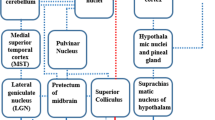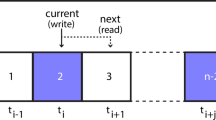Abstract
Human interaction in the computer environment requires conduciveness with minimal cybersickness. One such sickness is vection, where the subjects undergo illusory perception of self-motion in response to visual stimulus. The present research quantifies the perceptual parameter. An optokinetic drum (OKD) is used to induce circular vection on a virtual reality (VR), and the inertial measurement unit (IMU) in a head-mounted display (HMD) is used to track the head rotation about x, y, z axes. The study quantifies the vection in terms of the vection index (VI). The VI depends on the ratio of the angular velocity of HMD to the angular velocity of OKD. There is a significant difference from resting state to higher angular speeds in clockwise (CW) as well as anticlockwise (ACW) direction \((p<0.05)\). Also, the circular vection along the y-axis imparts the motion along the x and z axes. The magnitude of vection increases with speed in CW and ACW directions till the optimum speed of OKD. The vection is absent during very low and high speeds of OKD. Most participants experience the self-motion in an angular displacement range of 30–97\(^\circ /\)s in both CW and ACW directions. The vection in ACW compensates for the vection in CW direction about x, y and z axes.
Supported by organization IITM.
Access this chapter
Tax calculation will be finalised at checkout
Purchases are for personal use only
Similar content being viewed by others
References
Aitken, J.: 2. On a new variety of ocular spectrum. Proc. Royal Soc. Edinburgh 10, 40–44 (1880)
Allison, R.S., Zacher, J.E., Kirollos, R., Guterman, P.S., Palmisano, S.: Perception of smooth and perturbed vection in short-duration microgravity. Exp. Brain Res. 223(4), 479–487 (2012)
Aoki, M., Thilo, K.V., Burchill, P., Golding, J.F., Gresty, M.A.: Autonomic response to real versus illusory motion (vection). Clin. Auton. Res. 10(1), 23–28 (2000)
Aykent, B., Merienne, F., Guillet, C., Paillot, D., Kemeny, A.: Motion sickness evaluation and comparison for a static driving simulator and a dynamic driving simulator. Proc. Inst. Mech. Eng. Part D J. Autom. Eng. 228(7), 818–829 (2014)
Barnett-Cowan, M., Harris, L.: Perception of simultaneity and temporal order of active and passive head movements paired with visual, auditory and tactile stimuli. In: 9th International Multisensory Research Forum (IMRF 2008), p. 168 (2008)
Berntson, G.G., et al.: Heart rate variability: origins, methods, and interpretive caveats. Psychophysiology 34(6), 623–648 (1997)
Bles, W.: Stepping around circular vection and coriolis effects. In: Attention and Performance IX, pp. 47–61 (1981)
Brandt, T., Dichgans, J., Koenig, E.: Differential effects of central versus peripheral vision on egocentric and exocentric motion perception. Exp. Brain Res. 16(5), 476–491 (1973). https://doi.org/10.1007/BF00234474
Chelen, W., Kabrisky, M., Rogers, S.: Spectral analysis of the electroencephalographic response to motion sickness. Aviat. Space Environ. Med. 64(1), 24–29 (1993)
Cheung, B., Hofer, K., Heskin, R., Smith, A.: Physiological and behavioral responses to an exposure of pitch illusion in the simulator. Aviat. Space Environ. Med. 75(8), 657–665 (2004)
Cheung, B., Howard, I., Nedzelski, J., Landolt, J.: Circularvection about earth-horizontal axes in bilateral labyrinthine-defective subjects. Acta oto-laryngologica 108(5–6), 336–344 (1989)
Dennison, M.S., Wisti, A.Z., D’Zmura, M.: Use of physiological signals to predict cybersickness. Displays 44, 42–52 (2016)
Deutschländer, A., Bense, S., Stephan, T., Schwaiger, M., Dieterich, M., Brandt, T.: Rollvection versus linearvection: comparison of brain activations in pet. Human Brain Mapp. 21(3), 143–153 (2004)
Dichgans, J., Brandt, T.: Visual-vestibular interaction: effects on self-motion perception and postural control. In: Held, R., Leibowitz, H.W., Teuber, H.L. (eds.) Perception, pp. 755–804. Springer, Heidelberg (1978). https://doi.org/10.1007/978-3-642-46354-9_25
Ebenholtz, S.M.: Motion sickness and oculomotor systems in virtual environments. Pres. Teleoper. Virtual Environ. 1(3), 302–305 (1992)
Ebenholtz, S.M., Cohen, M.M., Linder, B.J.: The possible role of nystagmus in motion sickness: a hypothesis. Aviat. Space Environ. Med. 65(11), 1032–1035 (1994)
Ehrlich, J.A., Kolasinski, E.M.: A comparison of sickness symptoms between dropout and finishing participants in virtual environment studies. In: Proceedings of the Human Factors and Ergonomics Society Annual Meeting, vol. 42, pp. 1466–1470. SAGE Publications, Los Angeles (1998)
Fauville, G., Queiroz, A., Woolsey, E.S., Kelly, J.W., Bailenson, J.N.: The effect of water immersion on vection in virtual reality. Sci. Rep. 11(1), 1–13 (2021)
Fetter, M.: Vestibulo-ocular reflex. Neuro-Ophthalmol. 40, 35–51 (2007)
Fischer, M., Kornmüller, A.: Optokinetisch ausgelöste bewegungswahrnehmungen und optokinetischer nystagmus [perception of motion based on the optokinetic sense and optokinetic nystagmus]. J. für Psychologie und Neurologie 41, 273–308 (1930)
Guo, C., So, R.: Effects of foveal retinal slip on visually induced motion sickness: a pilot study. In: Proceedings of the Human Factors and Ergonomics Society Annual Meeting, vol. 56, pp. 2565–2569. SAGE Publications, Los Angeles (2012)
Himi, N., Koga, T., Nakamura, E., Kobashi, M., Yamane, M., Tsujioka, K.: Differences in autonomic responses between subjects with and without nausea while watching an irregularly oscillating video. Auton. Neurosci. 116(1–2), 46–53 (2004)
Holmes, S.R., Griffin, M.J.: Correlation between heart rate and the severity of motion sickness caused by optokinetic stimulation. J. Psychophysiol. 15(1), 35 (2001)
Hu, S., Grant, W.F., Stern, R.M., Koch, K.L.: Motion sickness severity and physiological correlates during repeated exposures to a rotating optokinetic drum. Aviat. Space Environ. Med. 62, 308–314 (1991)
Jaekl, P., Jenkin, M., Harris, L.R.: Perceiving a stable world during active rotational and translational head movements. Exp. Brain Res. 163(3), 388–399 (2005)
Jäger, M., Gruber, N., Müri, R., Mosimann, U.P., Nef, T.: Manipulations to reduce simulator-related transient adverse health effects during simulated driving. Med. Biol. Engi. Comput. 52(7), 601–610 (2014)
Jarmasz, J., Hollands, J.G.: Confidence intervals in repeated-measures designs: the number of observations principle. Can. J. Exp. Psychol./Revue canadienne de psychologie expérimentale 63(2), 124 (2009)
Ji, J.T., So, R.H., Cheung, R.T.: Isolating the effects of vection and optokinetic nystagmus on optokinetic rotation-induced motion sickness. Human Fact. 51(5), 739–751 (2009)
Jongkees, L.: Physiologie und pathophysiologie des vestibularorganes. Archiv für klinische und experimentelle Ohren-, Nasen-und Kehlkopfheilkunde 194(1), 1–110 (1969)
Kennedy, R.S., Stanney, K.M.: Postural instability induced by virtual reality exposure: development of a certification protocol. Int. J. Human-Comput. Interact. 8(1), 25–47 (1996)
Keshavarz, B., Berti, S.: Integration of sensory information precedes the sensation of vection: a combined behavioral and event-related brain potential (erp) study. Behav. Brain Res. 259, 131–136 (2014)
Keshavarz, B., Campos, J.L., Berti, S.: Vection lies in the brain of the beholder: EEG parameters as an objective measurement of vection. Front. Psychol. 6, 1581 (2015)
Keshavarz, B., Hettinger, L.J., Vena, D., Campos, J.L.: Combined effects of auditory and visual cues on the perception of vection. Exp. Brain Res. 232(3), 827–836 (2013). https://doi.org/10.1007/s00221-013-3793-9
Kim, J., Palmisano, S.: Eccentric gaze dynamics enhance vection in depth. J. Vision 10(12), 7 (2010)
Kim, Y.Y., Kim, H.J., Kim, E.N., Ko, H.D., Kim, H.T.: Characteristic changes in the physiological components of cybersickness. Psychophysiology 42(5), 616–625 (2005)
Kirollos, R., Allison, R.S., Palmisano, S.: Cortical correlates of the simulated viewpoint oscillation advantage for vection. Multisensory Res. 30(7–8), 739–761 (2017)
Kirollos, R., Herdman, C.M.: Measuring circular vection speed in a virtual reality headset. Displays 69, 102049 (2021)
Koohestani, A., et al.: A knowledge discovery in motion sickness: a comprehensive literature review. IEEE Access 7, 85755–85770 (2019)
Kothgassner, O.D.: Salivary cortisol and cardiovascular reactivity to a public speaking task in a virtual and real-life environment. Comput. Human Behav. 62, 124–135 (2016)
LaViola Jr., J.J.: A discussion of cybersickness in virtual environments. ACM Sigchi Bull. 32(1), 47–56 (2000)
Melcher, G.A., Henn, V.: The latency of circular vection during different accelerations of the optokinetic stimulus. Percept. Psychophys. 30(6), 552–556 (1981)
Nilsson, N.C., Nordahl, R., Sikström, E., Turchet, L., Serafin, S.: Haptically induced illusory self-motion and the influence of context of motion. In: Isokoski, P., Springare, J. (eds.) EuroHaptics 2012. LNCS, vol. 7282, pp. 349–360. Springer, Heidelberg (2012). https://doi.org/10.1007/978-3-642-31401-8_32
Owens, D.A., Gu, J., McNally, R.D.: Perception of the speed of self-motion vs. object-motion: another example of two modes of vision? Conscious. Cogn. 64, 61–71 (2018)
Palmisano, S., Allison, R.S., Schira, M.M., Barry, R.J.: Future challenges for vection research: definitions, functional significance, measures, and neural bases. Front. Psychol. 6, 193 (2015)
Palmisano, S., Barry, R.J., De Blasio, F.M., Fogarty, J.S.: Identifying objective EEG based markers of linear vection in depth. Front. Psychol. 7, 1205 (2016)
Palmisano, S., Burke, D., Allison, R.S.: Coherent perspective jitter induces visual illusions of self-motion. Perception 32(1), 97–110 (2003)
Palmisano, S., Gillam, B.: Stimulus eccentricity and spatial frequency interact to determine circular vection. Perception 27(9), 1067–1077 (1998)
Reason, J.T.: Motion sickness adaptation: a neural mismatch model. J. Royal Soc. Med. 71(11), 819–829 (1978)
Reason, J.T., Brand, J.J.: Motion Sickness. Academic press, Cambridge (1975)
Rebenitsch, L., Owen, C.: Review on cybersickness in applications and visual displays. Virtual Reality 20(2), 101–125 (2016). https://doi.org/10.1007/s10055-016-0285-9
Riccio, G.E., Stoffregen, T.A.: An ecological theory of motion sickness and postural instability. Ecol. Psychol. 3(3), 195–240 (1991)
Riecke, B.E., Feuereissen, D., Rieser, J.J., McNamara, T.P.: Spatialized sound enhances biomechanically-induced self-motion illusion (vection). In: Proceedings of the SIGCHI Conference on Human Factors in Computing Systems, pp. 2799–2802 (2011)
St George, R.J., Day, B.L., Fitzpatrick, R.C.: Adaptation of vestibular signals for self-motion perception. J. Physiol. 589(4), 843–853 (2011)
Stephan, T.: Functional MRI of galvanic vestibular stimulation with alternating currents at different frequencies. Neuroimage 26(3), 721–732 (2005)
Stern, R., Koch, K., Leibowitz, H., Lindblad, I., Shupert, C., Stewart, W.: Tachygastria and motion sickness. Aviat. Space Environ. Med. 56(11), 1074–1077 (1985)
Stern, R.M., Koch, K.L., Stewart, W.R., Lindblad, I.M.: Spectral analysis of tachygastria recorded during motion sickness. Gastroenterology 92(1), 92–97 (1987)
Strychacz, C., Viirre, E., Wing, S.: The use of EEG to measure cerebral changes during computer-based motion-sickness-inducing tasks. In: Biomonitoring for Physiological and Cognitive Performance during Military Operations, vol. 5797, pp. 139–148. International Society for Optics and Photonics (2005)
Tokumaru, O., Kaida, K., Ashida, H., Yoneda, I., Tatsuno, J.: EEG topographical analysis of spatial disorientation. Aviat. Space Environ. Medicine 70(3 Pt 1), 256–263 (1999)
Wan, H., Hu, S., Wang, J.: Correlation of phasic and tonic skin-conductance responses with severity of motion sickness induced by viewing an optokinetic rotating drum. Percept. Motor Skills 97(3_suppl), 1051–1057 (2003)
Watson, G.: A synthesis of simulator sickness studies conducted in a high-fidelity driving simulator. In: Proceedings of Driving Simulation Conference, pp. 69–78 (2000)
Webb, N.A., Griffin, M.J.: Optokinetic stimuli: motion sickness, visual acuity and eye movements. Aviat. Space Environ. Med. 73(4), 351–358 (2002)
Wibirama, S., Hamamoto, K.: Investigation of visually induced motion sickness in dynamic 3d contents based on subjective judgment, heart rate variability, and depth gaze behavior. In: 2014 36th Annual International Conference of the IEEE Engineering in Medicine and Biology Society, pp. 4803–4806. IEEE (2014)
Wiest, G., Amorim, M.A., Mayer, D., Schick, S., Deecke, L., Lang, W.: Cortical responses to object-motion and visually-induced self-motion perception. Cogn. Brain Res. 12(1), 167–170 (2001)
Wright, W., DiZio, P., Lackner, J.: Vertical linear self-motion perception during visual and inertial motion: more than weighted summation of sensory inputs. J. Vestib. Res. 15(4), 185–195 (2005)
Wu, J.P.: EEG changes in man during motion sickness induced by parallel swing. Space Med. Med. Eng. 5(3), 200–205 (1992)
Yang, X., Wang, D., Hu, H., Yue, K.: P-31: visual fatigue assessment and modeling based on ECG and EOG caused by 2D and 3D displays. In: SID Symposium Digest of Technical Papers, vol. 47, pp. 1237–1240. Wiley Online Library (2016)
Yang, J., Guo, C., So, R., Cheung, R.: Effects of eye fixation on visually induced motion sickness: are they caused by changes in retinal slip velocity? In: Proceedings of the Human Factors and Ergonomics Society Annual Meeting. vol. 55, pp. 1220–1224. SAGE Publications Sage CA, Los Angeles (2011)
Author information
Authors and Affiliations
Corresponding author
Editor information
Editors and Affiliations
Rights and permissions
Copyright information
© 2022 The Author(s), under exclusive license to Springer Nature Switzerland AG
About this paper
Cite this paper
Subudhi, D., Balaji, P., Muniyandi, M. (2022). Objective Quantification of Circular Vection in Immersive Environments. In: Chen, J.Y.C., Fragomeni, G. (eds) Virtual, Augmented and Mixed Reality: Design and Development. HCII 2022. Lecture Notes in Computer Science, vol 13317. Springer, Cham. https://doi.org/10.1007/978-3-031-05939-1_17
Download citation
DOI: https://doi.org/10.1007/978-3-031-05939-1_17
Published:
Publisher Name: Springer, Cham
Print ISBN: 978-3-031-05938-4
Online ISBN: 978-3-031-05939-1
eBook Packages: Computer ScienceComputer Science (R0)




